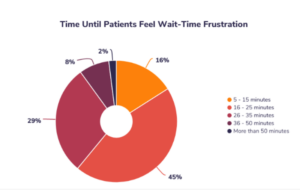How Wait Times Impact Patient Satisfaction
Nearly two out of every five patients are frustrated with their provider before their check-up even begins. Why do so many appointments start off on the wrong foot?
Well, the average patient wait time for healthcare organizations across the country is around 20 minutes—and that just won’t fly for a large portion of patients that were surveyed.
You may be thinking, “my patients don’t wait that long!” That may be true for most patients as the flow is quite different in a hearing care practice vs a family practice. However, we have heard from quite a few hearing care providers that patients are showing up earlier & earlier which can become schedule chaos.

Practices that fail to address these wait-time frustrations stand to lose up to 48% of their patient base in a year—and that’s not counting potential patients who avoid your practice after learning about long wait times through online reviews.
Failure to implement solutions in your waiting room will severely impact your ability to retain, attract, and satisfy patients.
16% of patients surveyed started feeling frustrated after only 5-15 min of waiting.

Wait times are like circus acts (no, really)
Circuses often feature risky balancing acts. So do medical practices—in the form of wait times.
Here’s the balancing act for healthcare providers: Schedule enough patients per day to cover practice costs, but try not to overbook the agenda. This is tougher than it sounds, considering health care providers must account for the unexpected, such as last-minute cancellations and no-shows.
No-show patients cost around $200 per unused time slot, and the average no-show rate for most U.S. practices hovers around 20%.
That’s a lot of lost revenue, so it’s understandable for practices to schedule as many patients as they can to mitigate the financial losses from missed appointments.
However, it’s also important to ensure wait times aren’t routinely long, because practices run the risk of upsetting the scheduling balance and causing patient satisfaction rates to crash.
In a physician survey, respondents were asked how often a patient at their practice encounters a wait time that is longer than 20 minutes for a scheduled appointment. Twenty-five percent said “daily” and 28% said “at least once a week.”
Why you can’t afford to have long wait times
One reason lengthy wait times are still so prevalent is that many healthcare providers simply don’t see them as an issue.
When asked how big of an impact they think patient wait times have on their practice’s ability to retain patients, 12% of doctors claimed “no impact at all” and 51% predicted a “minimal impact.”
That perception is contradicted by the results of a patient survey, which indicates that wait times do have a tremendous influence on whether people are loyal to a practice.
Nearly a quarter of patients say they’ve literally walked out of a waiting room, choosing to reschedule or even cancel rather than wait any longer.
Practices overbook patients to mitigate the effects of missed appointments, but the resulting long wait times can actually cause missed appointments.
Moreover, a patient’s negative experience with practice wait times has a ripple effect that extends from close friends and family to strangers on the internet.
Twenty-four percent of patients have discouraged their friends and family from seeing a certain doctor, and 14% have left critical comments on online review sites specifically because of practice wait times.
That’s a big deal because 41% of patients specifically look for information about wait times when evaluating new doctors through online reviews.

So, what’s the solution? Physicians can rely on a few valuable tools and strategies to help combat patient-related delays:
- Create, communicate, and enforce an arrivals policy
- Implement a digital signage/patient engagement strategy with CDM TV
Digital Signage Reduces Perceived Wait Times… And Improves Patient Satisfaction
Patients can be calmed by entertaining and educational content.
Patients feel more comfortable about an appointment when they understand the procedures or practice they are about to experience. Educational content can soothe your patient’s nerves as it offers a look at what is to come.
By providing information about what patients will experience during their appointment and educating them about the details of your practice or facility, you can make patients feel more confident and secure about their appointment or treatment.
You can also further support their wellbeing by using your waiting room digital signage to share supplemental information about how they take additional steps to improve their health, to educate family & caregivers on how to support the patient.
Your waiting room is a living, breathing marketing opportunity ripe for building patient loyalty.
Transform waiting periods from instances of irritation into opportunities for interaction.


